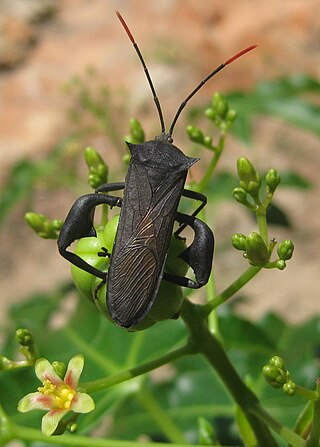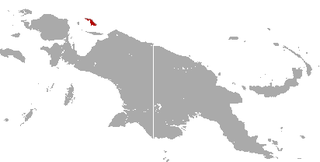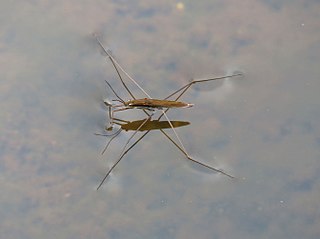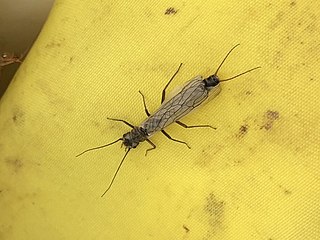
Kōkako are two species of forest bird in the genus Callaeas which are endemic to New Zealand, the endangered North Island kōkako and the presumed extinct South Island kōkako. They are both slate-grey with wattles and have black masks. They belong to a family containing five species of New Zealand wattlebirds, the other three being two species of tīeke (saddleback) and the extinct huia. Previously widespread, kōkako populations throughout New Zealand have been decimated by the predations of mammalian invasive species such as possums, stoats, cats and rats, and their range has contracted significantly. In the past this bird was called the New Zealand crow. It is not closely related to the crow, but looks like one from a distance.

Coreidae is a large family of predominantly sap-sucking insects in the Hemipteran suborder Heteroptera. The name "Coreidae" derives from the genus Coreus, which derives from the Ancient Greek κόρις (kóris) meaning bedbug.

The blue-eyed spotted cuscus or Biak spotted cuscus is a species of critically endangered marsupial in the family Phalangeridae.

Anisoscelini is a tribe of leaf-footed bugs in the family Coreidae. It was formerly spelled Anisoscelidini, but the tribal name spelling was incorrectly formed.
The Chronicles of Narnia is a series of seven fantasy novels for children written by C. S. Lewis. It is considered a classic of children's literature and is the author's best-known work, having sold over 100 million copies in 47 languages. Written by Lewis between 1949 and 1954, illustrated by Pauline Baynes and published in London between October 1950 and March 1956, The Chronicles of Narnia has been adapted several times, complete or in part, for television, radio, the stage, film, in audio books, and as video games.
Orthopodomyia is a genus of mosquitoes in the family Culicidae. There are at least 40 described species in Orthopodomyia.

Limnoporus is a genus of water striders in the family Gerridae. There are six extant described species in Limnoporus.
Euxoa wilsoni is a species of cutworm or dart moth in the family Noctuidae. It is found in North America.

Paraperla is a genus of green stoneflies in the family Chloroperlidae. There are at least two described species in Paraperla.

Psallus is a genus of plant bugs in the family Miridae. There are more than 170 described species in Psallus.
Mixogaster breviventris is a species of syrphid fly in the family Syrphidae.
Chrysotoxum chinook is a species of syrphid fly in the family Syrphidae.
Aradus funestus is a species of flat bug in the family Aradidae. It is found in North America.
Pilophorus tibialis is a species of plant bug in the family Miridae. It is found in Central America and North America.
Aradus depictus is a species of flat bug in the family Aradidae. It is found in North America.
Plagiognathus brunneus is a species of plant bug in the family Miridae. It is found in North America.

Narnia is a genus of leaf-footed bugs in the family Coreidae. There are six described species in Narnia.

Narnia snowi is a species of leaf-footed bug in the family Coreidae. It is found in North America.

Narnia femorata is a species of leaf-footed bug in the family Coreidae. It is found in Central America and North America.
Torrejonia is a genus of extinct plesiadapiform that belongs to the family Palaechthonidae. There are currently two species known, T. wilsoni and T. sirokyi. This genus is present in the fossil record from around 62–58 Ma. Species belonging to this genus are suggested to be plesiadapiforms based on adaptations observed in the skeletal morphology consistent with arboreal locomotor behavior. Following the mass extinction event at the Cretaceous–Paleogene boundary (K-Pg), a large diversity of plesiadapiform families were documented beginning at the Torrejonian NALMA. Research has shown that T. wilsoni is one of the largest palaechthonids and is reconstructed as being more frugivorous than other palaechthonids.









